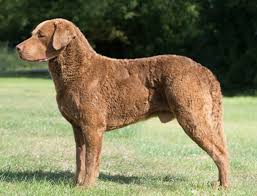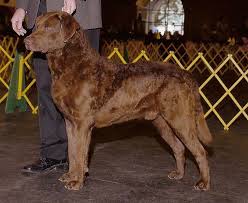The Chesapeake Bay Retriever is a powerful and sturdy breed of dog that has been a beloved hunting companion for centuries. Known for their unwavering loyalty and tenacity in the field, Chesapeake Bay Retrievers are also beloved family pets and make excellent watchdogs due to their protective nature.
Originating from the eastern shore of the Chesapeake Bay in Maryland in the 1800s, Chesapeake Bay Retrievers were originally bred to retrieve waterfowl in the harsh conditions of the bay. Their thick, oily coat helps to insulate them from the cold water, while their strong swimming ability and webbed feet make them efficient swimmers.
One of the most unique characteristics of the Chesapeake Bay Retriever is their coat, which can come in a variety of shades ranging from brown to reddish-gold. Their coat is thick and water-repellent, making them well-suited to hunting and retrieving in the water. However, this also means that they require regular grooming to keep their coat healthy and free of mats.
Chesapeake Bay Retrievers are known for their intelligence and trainability, although they can be stubborn at times. They require firm but gentle training from a young age, with plenty of socialization to ensure that they grow up to be well-adjusted and obedient dogs. Due to their protective nature, Chesapeake Bay Retrievers can make excellent guard dogs, but they require proper socialization to ensure that they do not become overly aggressive.
Like all dogs, Chesapeake Bay Retrievers require plenty of exercise and mental stimulation to stay healthy and happy. They enjoy a good run or swim, and they love to play games such as fetch or tug-of-war. They also enjoy learning new tricks and commands, making them an excellent choice for obedience or agility training.
In terms of health, Chesapeake Bay Retrievers are generally a healthy breed with a lifespan of around 10-12 years. However, they are prone to certain health issues such as hip dysplasia, progressive retinal atrophy, and bloat. Regular vet check-ups and proper nutrition are important to ensure that your Chesapeake Bay Retriever stays healthy and happy throughout their life.
Overall, the Chesapeake Bay Retriever is a loyal and loving breed that makes an excellent hunting companion, family pet, and watchdog. With proper training and socialization, they can be a great addition to any household and will provide years of love and companionship to their owners.
Read Also: Concepts of Agribusiness Management and Its Elements
History and Origin of the Chesapeake Bay Retriever

The Chesapeake Bay Retriever is a breed of dog that originated in the United States in the early 19th century. The breed was developed to assist hunters in retrieving waterfowl in the rough and icy waters of the Chesapeake Bay, which is located on the east coast of the United States.
The exact origin of the breed is not known for certain, but it is believed that it was developed through a combination of different breeds, including the English Water Spaniel, the Newfoundland, and possibly the Irish Water Spaniel. The breed was specifically developed to be able to withstand the harsh conditions of the Chesapeake Bay, which is known for its rough waters and cold temperatures.
The breed was first recognized by the American Kennel Club in 1885, and has since become a popular breed among hunters and dog lovers alike. Chesapeake Bay Retrievers are now used for a variety of purposes, including hunting, search and rescue, and as family pets.
The breed’s history is also tied to an interesting legend. According to the story, in 1807 a ship carrying two Newfoundlands that were intended as gifts for the King of England was shipwrecked off the coast of Maryland.
The dogs were saved by local fishermen, and were later bred with local retrievers to create the Chesapeake Bay Retriever. While the story is likely apocryphal, it is still a part of the breed’s lore and adds to its mystique.
Today, the Chesapeake Bay Retriever is recognized as a strong and loyal breed that is well-suited to a variety of roles. They are prized for their ability to retrieve game in water, and their friendly and outgoing personalities make them popular as family pets.
Despite being a relatively rare breed, Chesapeake Bay Retrievers are beloved by their owners and continue to make a significant contribution to the hunting and sporting world.
Health Issues and Lifespan of Chesapeake Bay Retriever Dogs

Hip Dysplasia: This is a common condition in many large breeds of dogs, including the Chesapeake Bay Retriever. It is a developmental condition in which the hip joint doesn’t form properly, causing pain and inflammation. Hip dysplasia can lead to arthritis and mobility problems, and may require surgical intervention.
Progressive Retinal Atrophy (PRA): This is an inherited eye disorder that can lead to blindness. The condition typically begins with night blindness and progresses to complete loss of vision. There is no cure for PRA, but early diagnosis can help to slow the progression of the disease.
Bloat: This is a serious condition in which the stomach fills with gas and twists, causing a blockage. Bloat can be life-threatening and requires immediate veterinary attention. Chesapeake Bay Retrievers are at higher risk for bloat due to their deep chests, so it is important to monitor their diet and exercise to reduce the risk of the condition.
Lifespan: The Chesapeake Bay Retriever has an average lifespan of 10-12 years. However, with proper care and attention, many dogs live well beyond this age range.
To keep your Chesapeake Bay Retriever healthy, it is important to provide regular veterinary care and to monitor their diet and exercise. Regular exercise is important to maintain their physical and mental health, and a balanced diet can help to prevent obesity and other health problems. By being aware of the potential health issues that may affect your Chesapeake Bay Retriever and taking steps to prevent them, you can help to ensure that your dog lives a long and healthy life.
Read Also: How Fortified Molasses helps for Survival Feeding of Beef Cattle
Chesapeake Bay Retriever Dog Breed Complete Grooming and Care Guide

Coat Care: The Chesapeake Bay Retriever has a thick, waterproof coat that requires regular grooming. Brush their coat at least once a week to remove loose hair and prevent mats from forming. During shedding season, you may need to brush their coat more often. Bathing should be done as needed, but should not be done too frequently as it can strip the coat of its natural oils.
Nail Care: Trim your dog’s nails regularly to prevent them from getting too long and causing discomfort. You can use a pair of dog nail clippers or have a professional groomer do it for you. Be careful not to cut the quick, which is the blood vessel that runs through the nail.
Dental Care: Regular dental care is important to maintain your dog’s oral health. Brush their teeth at least two to three times a week with a dog toothbrush and toothpaste. You can also provide dental chews or toys to help keep their teeth clean.
Ear Care: Check your dog’s ears regularly for signs of infection, such as redness, swelling, or a foul odor. Clean their ears with a cotton ball and ear cleaner designed for dogs.
Exercise: The Chesapeake Bay Retriever is an active breed that requires daily exercise. Take your dog for a walk, run, or swim every day to help keep them physically and mentally stimulated.
Diet: Feed your dog a high-quality, balanced diet that is appropriate for their age and activity level. Be mindful of portion sizes and avoid overfeeding, which can lead to obesity and other health problems.
Training: The Chesapeake Bay Retriever is a smart and trainable breed, but they can be stubborn at times. Consistent and positive training methods will help them to learn quickly and develop good behavior.
Health Care: Regular veterinary care is important to maintain your dog’s health. Schedule annual check-ups and vaccinations, and be vigilant for signs of illness or injury.
By following these grooming and care tips, you can help to keep your Chesapeake Bay Retriever healthy, happy, and well-groomed.
Read Also: Watershed Pollution Solutions and Management
